Evaluation of Ecosystem Service Value of Homegarden in Chengdu Plain and Relevant Protection Strategy
Abstract
:1. Introduction
2. Study Area and Methods
2.1. Study Area
2.2. Research Methods
2.2.1. Interpretation of HGs
- (1)
- Establishing interpretation rules
- (2)
- Extracting HG patches
- (3)
- Verification of interpretation results
2.2.2. Evaluation of Ecosystem Service Values
- (1)
- Evaluation framework of HG ecosystem services
- (2)
- Evaluation methods of HG ecosystem services
2.2.3. Zone Division of HG Based on Protection Importance
- (1)
- Comprehensive quality index evaluation of HG
- (2)
- Damage risk index evaluation of HG
- (3)
- Zone division of HG based on importance
3. Research Results
3.1. Quantity and Distribution of HGs
3.2. Ecosystem Service Value of HGs
3.3. Protection Zone Division of HGs
4. Discussions
4.1. Importance of the Ecosystem Service Value of HGs
4.2. Composition Structures and Functional Changes of HGs
4.3. Suggestions for the Sustainable Protection of HGs
5. Conclusions
Author Contributions
Funding
Data Availability Statement
Conflicts of Interest
References
- Soemarwoto, O.; Christanty, L. Homegarden in the tropics. In Proceedings of the First International Workshop on Tropical Homegarden, Bandung, Indonesia, 2–9 December 1985. [Google Scholar]
- Kumar, B.M.; Nair, P. The enigma of tropical homegardens. Agrofor. Syst. 2004, 61, 135–152. [Google Scholar]
- Nath, A.J.; Das, A.K. Carbon storage and sequestration in bamboo-based smallholder homegardens of Barak Valley, Assam. Curr. Sci. 2011, 100, 229–233. [Google Scholar]
- Galhena, D.H.; Freed, R.; Maredia, K.M. Home gardens: A promising approach to enhance household food security and wellbeing. Agric. Food Secur. 2013, 2, 8. [Google Scholar] [CrossRef]
- Karthigesu, J.; Sivachndiran, S.; Pushpakumara, D. Ecosystem services of homegarden agroforestry in Jaffna Peninsula. In Proceedings of the International Conference on Dry Zone Agriculture, Jaffna, Sri Lanka, 15 December 2016. [Google Scholar]
- Bardhan, S.; Jose, S.; Biswas, S.; Kabir, K.; Rogers, W. Homegarden agroforestry systems: An intermediary for biodiversity conservation in Bangladesh. Agrofor. Syst. 2012, 85, 29–34. [Google Scholar] [CrossRef]
- Mohri, H.; Lahoti, S.; Saito, O.; Mahalingam, A.; Gunatilleke, N.; Irham; Hoang, V.T.; Hitinayake, G.; Takeuchi, K.; Herath, S. Assessment of ecosystem services in homegarden systems in Indonesia, Sri Lanka, and Vietnam. Ecosyst. Serv. 2013, 5, 124–136. [Google Scholar] [CrossRef]
- Lowenstein, D.M.; Matteson, K.C.; Minor, E.S. Diversity of wild bees supports pollination services in an urbanized landscape. Oecologia 2015, 179, 811–821. [Google Scholar] [CrossRef]
- Castro, A.; Lascurain, R.M.; Gómez-Díaz, J.A.; Sosa, V. Mayan Homegardens in Decline: The Case of the Pitahaya (Hylocereusundatus), a Vine Cactus with Edible Fruit. Trop. Conserv. Sci. 2018, 11, 1940082918808730. [Google Scholar] [CrossRef]
- Chakravarty, S.; Pala, N.A.; Tamang, B.; Sarkar, B.C.; Manohar, K.A.; Rai, P.; Puri, A.; Vineeta; Shukla, G. Ecosystem Services of Trees Outside Forest. In Sustainable Agriculture, Forest and Environmental Management; Springer: Berlin/Heidelberg, Germany, 2019; Volume 31. [Google Scholar]
- Norfolk, O.; Eichhorn, M.P.; Gilbert, F. Traditional agricultural gardens conserve wild plants and functional richness in arid South Sinai. Basic Appl. Ecol. 2013, 14, 659–669. [Google Scholar] [CrossRef]
- Taylor, J.R.; Lovell, S.T. Urban homegardens in the Global North: A mixed methods study of ethnic and migrant home gardens in Chicago, Illinois. Renew. Agric. Food Syst. 2015, 1, 22–32. [Google Scholar] [CrossRef]
- Wolch, J.R.; Byrne, J.; Newell, J.P. Urban green space, public health, and environmental justice: The challenge of making cities “just green enough”. Landsc. Urban Plan. 2014, 125, 234–244. [Google Scholar] [CrossRef]
- Panyadee, P.; Balslev, H.; Wangpakapattanawong, P.; Inta, A. Woody Plant Diversity in Urban Homegardens in Northern Thailand. Econ. Bot. 2016, 70, 285–302. [Google Scholar] [CrossRef]
- Hails, R.S.; Ormerod, S.J. Ecological science for ecosystem services and the stewardship of Natural Capital. J. Appl. Ecol. 2013, 50, 807–811. [Google Scholar] [CrossRef]
- Brown, G.; Schebella, M.F.; Weber, D. Using participatory GIS to measure physical activity and urban park benefits. Landsc. Urban Plan. 2014, 121, 34–44. [Google Scholar] [CrossRef]
- Luo, S.; Shi, J.; Lu, T.; Furuya, K. Sit down and rest: Use of virtual reality to evaluate preferences and mental restoration in urban park pavilions. Landsc. Urban Plan. 2022, 220, 104336. [Google Scholar] [CrossRef]
- Vibhuti, K.; Bargali, S.S. Effect of size and altitude on soil organic carbon stock in homegarden agroforestry system in Central Himalaya, India. Acta Ecol. Sin. 2020, 40, 483–491. [Google Scholar]
- Caballero-Serrano, V.; Onaindia, M.; Alday, J.G.; Caballero, D.; Carrasco, J.C.; McLaren, B.; Amigo, J. Plant diversity and ecosystem services in Amazonian homegardens of Ecuador. Agric. Ecosyst. Environ. 2016, 225, 116–125. [Google Scholar] [CrossRef]
- Baul, T.K.; Chakraborty, A.; Nandi, R.; Nath, T.K.; Mohiuddin, M. Phytosociological Attributes and Ecosystem Services of Homegardens of Maheshkhali Island of Bangladesh. Trees For. People 2021, 5, 100092. [Google Scholar] [CrossRef]
- Nebel, G. Sustainable land-use in Peruvian flood plain forests: Options, planning and implementation. For. Ecol. Manag. 2001, 150, 187–198. [Google Scholar] [CrossRef]
- Trinh, L.; Watson, J.; Hue, N.; De, N.; Minh, N.; Chu, P.; Sthapit, B.; Eyzaguirre, P. Agrobiodiversity conservation and development in Vietnamese home gardens. Agric. Ecosyst. Environ. 2003, 97, 317–344. [Google Scholar] [CrossRef]
- Kabir, M.E.; Webb, E.L. Household and homegarden characteristics in southwestern Bangladesh. Agrofor. Syst. 2009, 75, 129–145. [Google Scholar] [CrossRef]
- Chen, Q.B. Researches on the Modes about Conservation and Development of Linpan in Western Sichuan Plain; Chinese Forestry Press: Beijing, China, 2011. [Google Scholar]
- Fang, Z.R.; Zhou, J.H. Population, Cultivated Land and the Self-organization of Traditional Rural Settlement—With the Case of the Linpan Settlement System (1644–1911) in Chuanxi Plain. Hum. Habitat Environ. 2011, 27, 83–87. [Google Scholar]
- Shu, B. Studies of Agricultural Landscape in Chengdu Plain; Southwest Jiaotong University Press: Chengdu, China, 2012. [Google Scholar]
- Maroyi, A. Traditional homegardens and rural livelihoods in Nhema, Zimbabwe: A sustainable agroforestry system. Int. J. Sustain. Dev. World Ecol. 2009, 16, 1–8. [Google Scholar] [CrossRef]
- Saha, S.K.; Nair, P.K.R.; Nair, V.D.; Kumar, B.M. Soil carbon stock in relation to plant diversity of homegardens in Kerala, India. Agrofor. Syst. 2009, 76, 53–65. [Google Scholar] [CrossRef]
- Panyadee, P.; Balslev, H.; Wangpakapattanawong, P.; Inta, A. Karen Homegardens: Characteristics, Functions, and Species Diversity. Econ. Bot. 2018, 72, 1–19. [Google Scholar] [CrossRef]
- Cai, S.T. The Protection Planning of LinPan in New Rural Construction. Sichuan Archit. 2007, 27, 4–6. [Google Scholar]
- Guo, Y.M. Study on Spatial-Temporal Variation Characteristics and Driving Forces of Linpan in Chengdu Plain—A Case of Pi County; University of Chinese Academy of Sciences: Beijing, China, 2018. [Google Scholar]
- Zhou, Y.; Chen, J. Landscape Pattern Change and Its Driving Forces in the Linpan of Western Sichuan. J. Sichuan Agric. Univ. 2017, 35, 241–255. [Google Scholar]
- Seidl, R.; Albrich, K.; Erb, K.; Formayer, H.; Leidinger, D.; Leitinger, G.; Tappeiner, U.; Tasser, E.; Rammer, W. What drives the future supply of regulating ecosystem services in a mountain forest landscape? For. Ecol. Manag. 2019, 445, 37–47. [Google Scholar] [CrossRef]
- Hernández-Blanco, M.; Costanza, R.; Cifuentes-Jara, M. Economic valuation of the ecosystem services provided by the mangroves of the Gulf of Nicoya using a hybrid methodology. Ecosyst. Serv. 2021, 49, 101258. [Google Scholar] [CrossRef]
- Mukherjee, N.; Sutherland, W.J.; Dicks, L.; Hugé, J.; Koedam, N.; Dahdouh-Guebas, F. Ecosystem Service Valuations of Mangrove Ecosystems to Inform Decision Making and Future Valuation Exercises. PLoS ONE 2014, 9, e107706. [Google Scholar] [CrossRef]
- Himes-Cornell, A.; Pendleton, L.; Atiyah, P. Valuing Ecosystem Services from Blue Forests: A systematic review of the valuation of salt marshes, sea grass beds and mangrove forests. Ecosyst. Serv. 2018, 30 Pt A, 36–48. [Google Scholar] [CrossRef]
- Liu, Q.; Wang, Y.K.; Guo, Y.M.; Peng, P.H.; Wang, K.Y. Morphological characteristics and composition of plant species and their distribution patterns in Linpan of Chengdu plain. Acta Ecol. Sin. 2018, 38, 3553–3561. [Google Scholar]
- Wang, J.X.; Mu, C.L.; Peng, P.H.; Hu, Z.Y. Monitoring and Evaluation of Ecological Benefits of Shelter Forest System in the Middle and Upper Reaches of the Yangtze River; Sichuan Scientific and Technological Press Co., Ltd.: Chengdu, China, 2006. [Google Scholar]
- Wang, Y.K.; Deng, Y.L.; Peng, P.H.; Fan, J.R. Theoretical and Technical Research on Ecological Barrier Construction in the Upper Reaches of the Yangtze River; Sichuan Scientific and Technological Press Co., Ltd.: Chengdu, China, 2005. [Google Scholar]
- Liu, B.T.; Song, C.F.; Tao, H.P. Quantitative Assessment of Soil Erosion of Chengdu City. J. Yangtze River Sci. Res. Inst. 2016, 33, 40–47. [Google Scholar]
- Liu, Q.; Wang, Y.K.; Xu, P.; Peng, P. Value Estimate of Carbon Fixation and Oxygen of Linpan and Its Characteristics-a Case of Pixian, Chengdu Plain. Southwest China J. Agric. Sci. 2018, 31, 1732–1738. [Google Scholar]
- Xie, G.D.; Zhang, C.X.; Zhang, C.S.; Xiao, Y.; Lu, C.X. The value of ecosystem services in China. Resour. Sci. 2015, 37, 1740–1746. [Google Scholar]
- FAOSTAT. Food and Agriculture Data. Available online: https://faostat.fao.org/site/291/defaultaspx (accessed on 10 April 2021).
- Liu, Q.; Xu, P.; Wang, Y.; Peng, P.; Liu, Y. Ecosystem Provisioning Services Valuation of Linpan in Chengdu Plain. Ecol. Econ. 2018, 34, 195–200. [Google Scholar] [CrossRef]
- Statistic Bureau of Chengdu. Chengdu Statistical Yearbook; China Statistics Press: Beijing, China, 2020.
- Xiao, Y.; Ouyang, Z.Y.; Wang, L.Y.; Rao, E.; Jiang, L.; Zhang, L. Spatial Patterns of Ecosystem Quality in Inner Mongolia and its Driving forces analysis. Acta Ecol. Sin. 2016, 36, 6019–6030. [Google Scholar]
- De Leijster, V.; Santos, M.J.; Wassen, J.M.; Camargo García, J.C.; Llorca Fernandez, I.; Verkuil, L.; Scheper, A.; Steenhuis, M.; Verweij, P.A. Ecosystem services trajectories in coffee agroforestry in Colombia over 40 years. Ecosyst. Serv. 2021, 48, 101246. [Google Scholar] [CrossRef]
- Kehlenbeck, K. Rural Homegardens in Central Sulawesi, Indonesia: An Example for a Sustainable Agro-Ecosystem? Georg-August-University: Göttingen, Germany, 2007. [Google Scholar]
- Coomes, O.T.; Ban, N. Cultivated plant species diversity in home gardens of an Amazonian peasant village in northeastern Peru. Econ. Bot. 2004, 59, 420–434. [Google Scholar] [CrossRef]
- Bagstad, K.J.; Johnson, G.W.; Voigt, B.; Villa, F. Spatial dynamics of ecosystem service flows: A comprehensive approach to quantifying actual services. Ecosyst. Serv. 2013, 41, 17–125. [Google Scholar] [CrossRef]
- Rasheed, S.; Venkatesh, P.; Singh, D.R.; Renjini, V.; Jha, G.K.; Sharma, D.K. Ecosystem valuation and eco-compensation for conservation of traditional paddy ecosystems and varieties in Kerala, India. Ecosyst. Serv. 2021, 49, 101272. [Google Scholar] [CrossRef]
- Tapasi, D.; Ashesh, K.D. Conservation of Plant Diversity in Rural Homegardens with Cultural and Geographical Variation in Three Districts of Barak Valley, Northeast India. Econ. Bot. 2015, 69, 57–71. [Google Scholar]
- Albuquerque, U.P.; Andrade, L.; Caballero, J. Structure and floristics of homegardens in Northeastern Brazil. J. Arid Environ. 2005, 62, 491–506. [Google Scholar] [CrossRef]
- Folke, C.; Carpenter, S.R.; Walker, B.; Scheffer, M.; Chapin, T.; Rockström, J. Resilience thinking: Integrating resilience, adaptability and transformability. Ecol. Soc. 2010, 15, 299–305. [Google Scholar] [CrossRef]
- Perfecto, I.; Vandermeer, J. Biodiversity conservation in tropical agroecosystems: A new conservation paradigm. Ann. N. Y. Acad. Sci. 2008, 1134, 173–200. [Google Scholar] [CrossRef]
- Mattsson, E.; Ostwald, M.; Nissanka, S.P.; Pushpakumara, D.K.N.G. Quantification of carbon stock and tree diversity of homegardens in a dry zone area of Moneragala district, Sri Lanka. Agrofor. Syst. 2015, 89, 435–445. [Google Scholar] [CrossRef]
- Motzke, I.; Klein, A.-M.; Saleh, S.; Wanger, T.C.; Tscharntke, T. Habitat management on multiple spatial scales can enhance bee pollination and crop yield in tropical homegardens. Agric. Ecosyst. Environ. 2016, 223, 144–151. [Google Scholar] [CrossRef]
- Lemonsu, A.; Masson, V. Inclusion of vegetation in the Town Energy Balance model for modelling urban green areas. Geosci. Model Dev. Discuss. 2012, 5, 1295–1340. [Google Scholar] [CrossRef]
- Wratten, S.D.; Gillespie, M.; Decourtye, A.; Mader, E.; Desneux, N. Pollinator habitat enhancement: Benefits to other ecosystem services. Agric. Ecosyst. Environ. 2012, 159, 112–122. [Google Scholar] [CrossRef]
- Melathopoulos, A.P.; Cutler, G.C.; Tyedmers, P. Where is the value in valuing pollination ecosystem services to agriculture? Ecol. Econ. 2015, 109, 59–70. [Google Scholar] [CrossRef]
- Roschewitz, I.; Gabriel, D.; Tscharntke, T.; Thies, C. The effects of landscape complexity on arable weed species diversity in organic and conventional farming. J. Appl. Ecol. 2005, 42, 873–882. [Google Scholar] [CrossRef]
- Rossum, F.V. Reproductive success and pollen dispersal in urban populations of an insect-pollinated hay-meadow herb. Perspect. Plant Ecol. Evol. Syst. 2010, 12, 21–29. [Google Scholar] [CrossRef]
- Nath, T.; Inoue, M. Forest-based settlement project and its impacts on community livelihood in the Chittagong Hill Tracts, Bangladesh. Int. For. Rev. 2009, 11, 394–407. [Google Scholar] [CrossRef]
- Goulson, D. Review: An overview of the environmental risks posed by neonicotinoid insecticides. J. Appl. Ecol. 2013, 50, 977–987. [Google Scholar] [CrossRef]

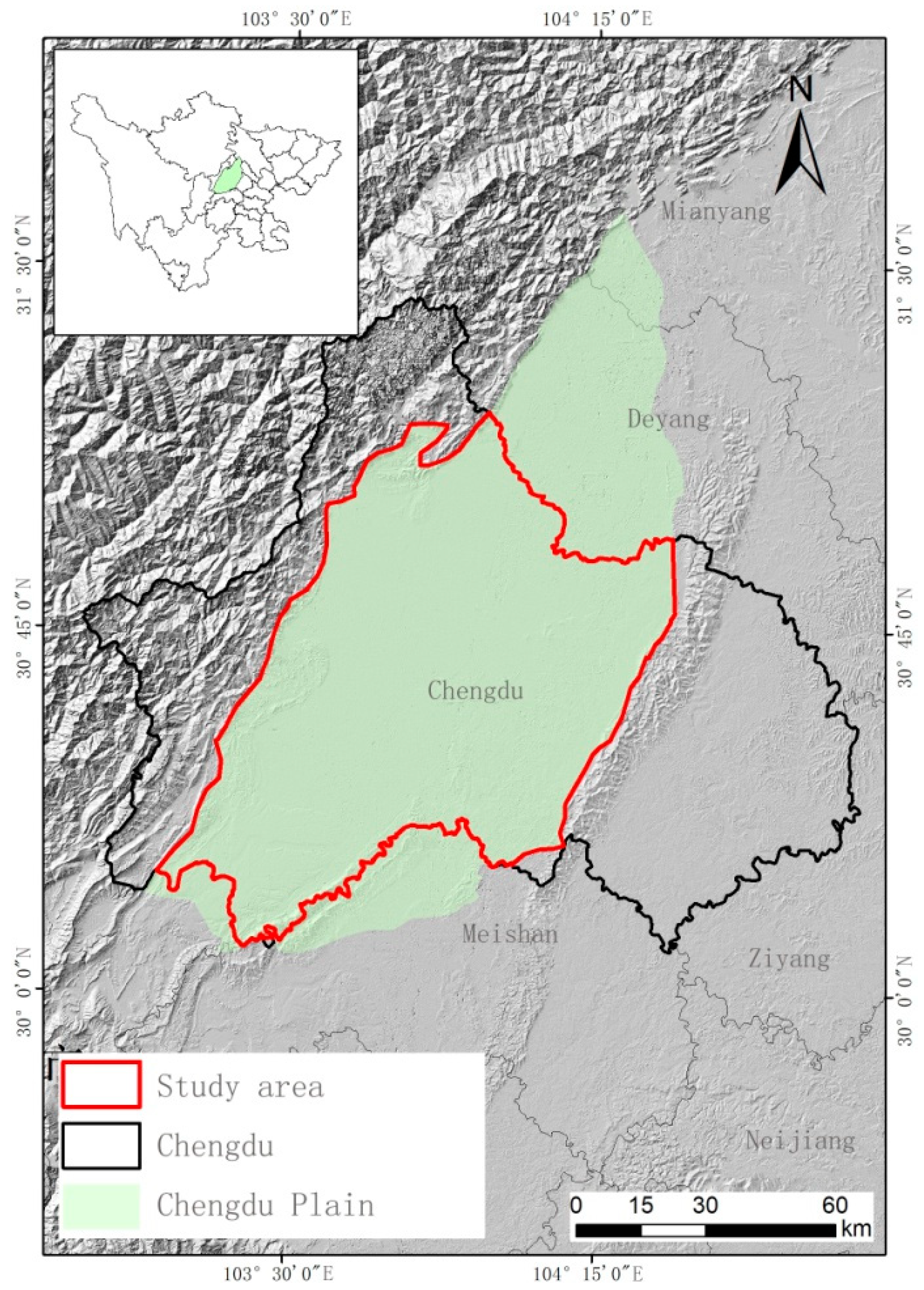
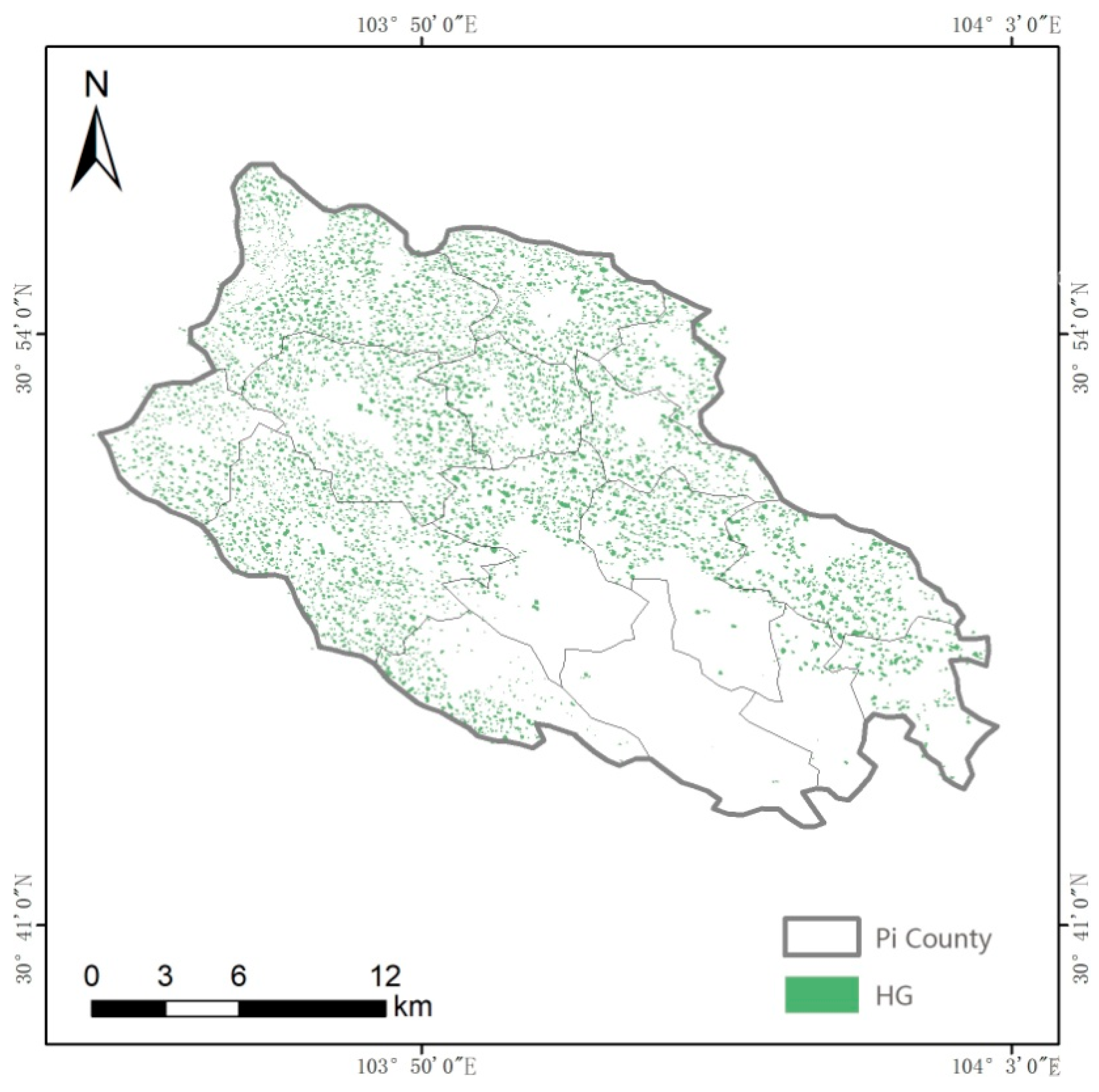

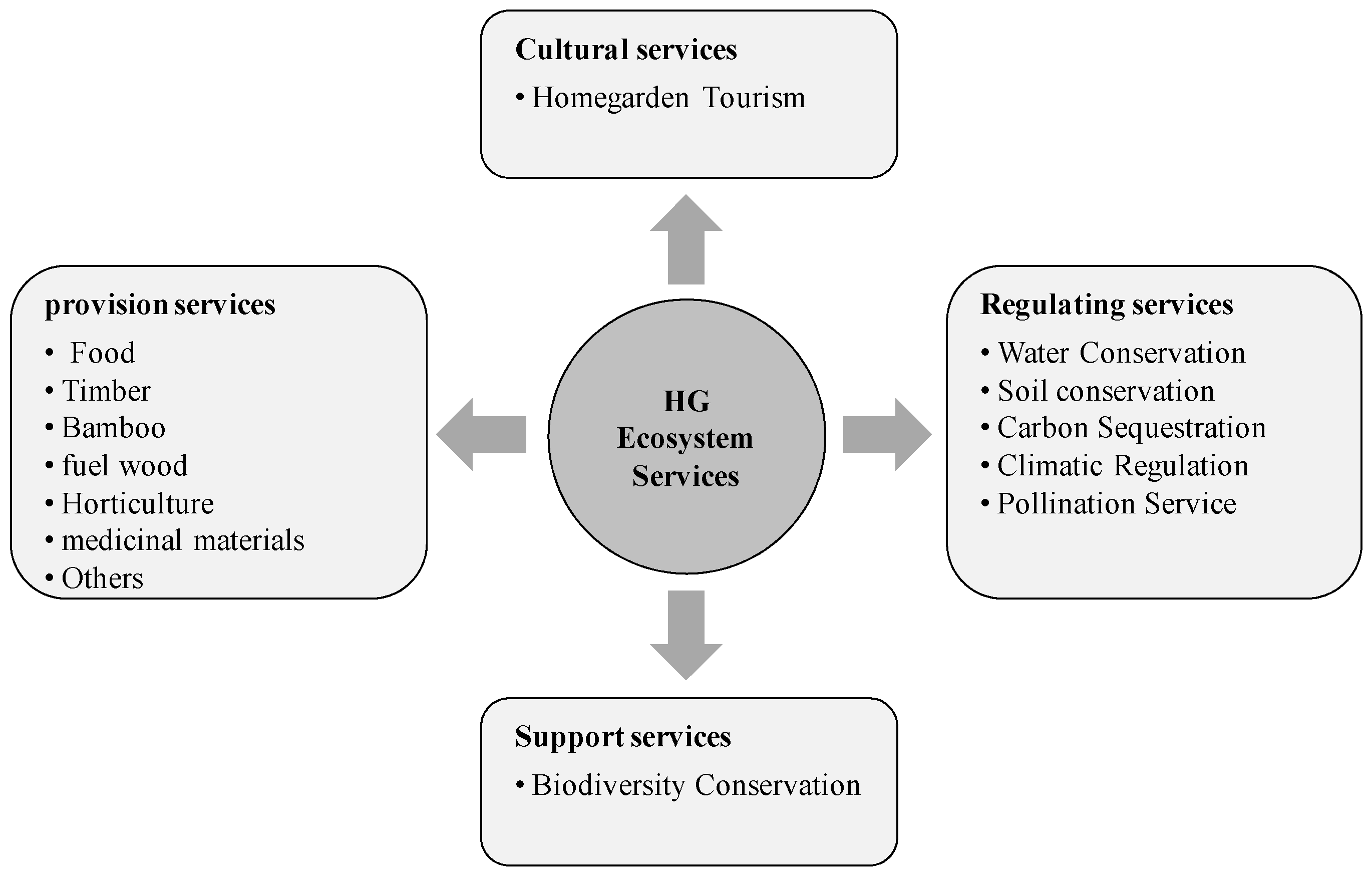
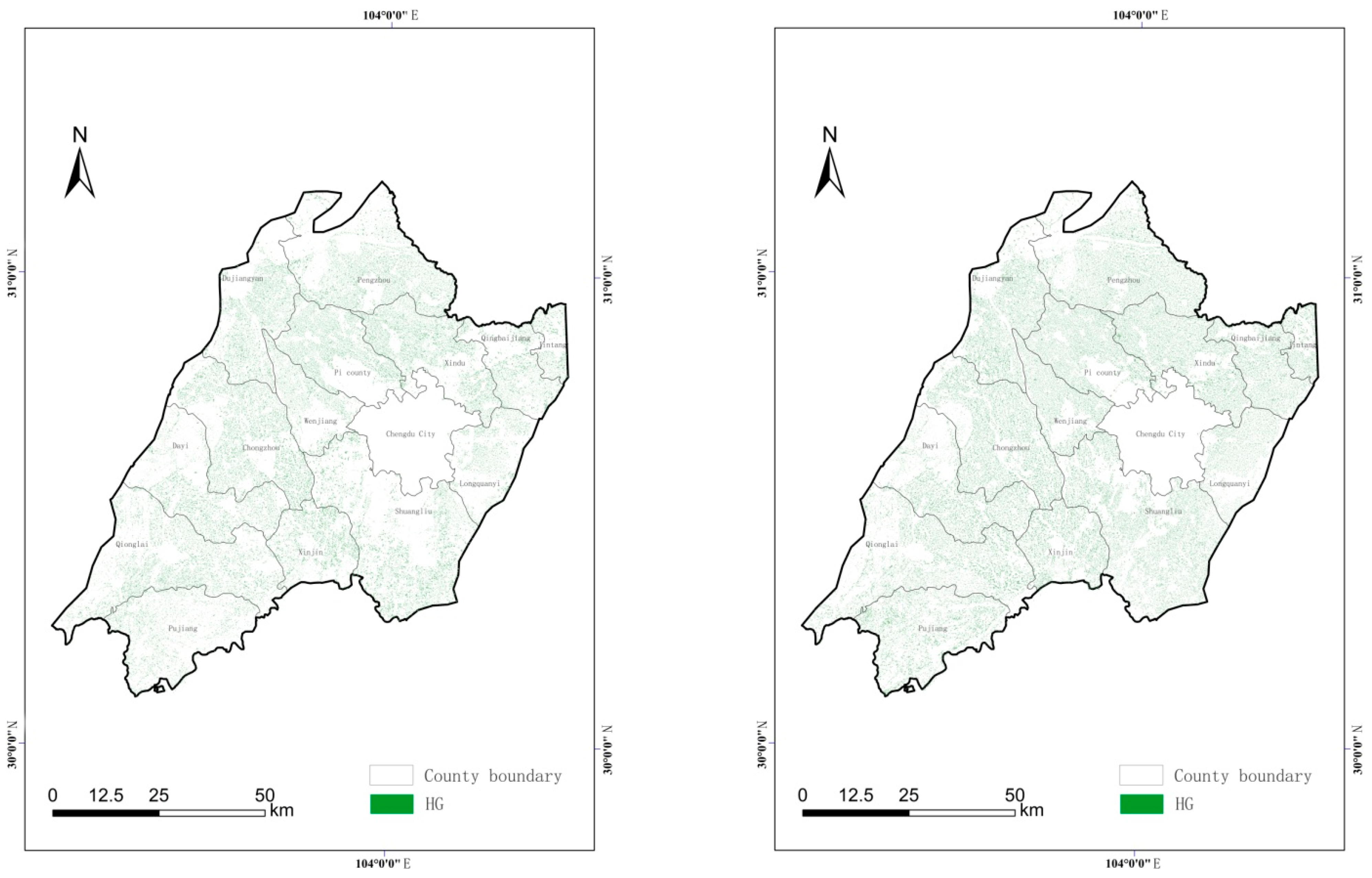
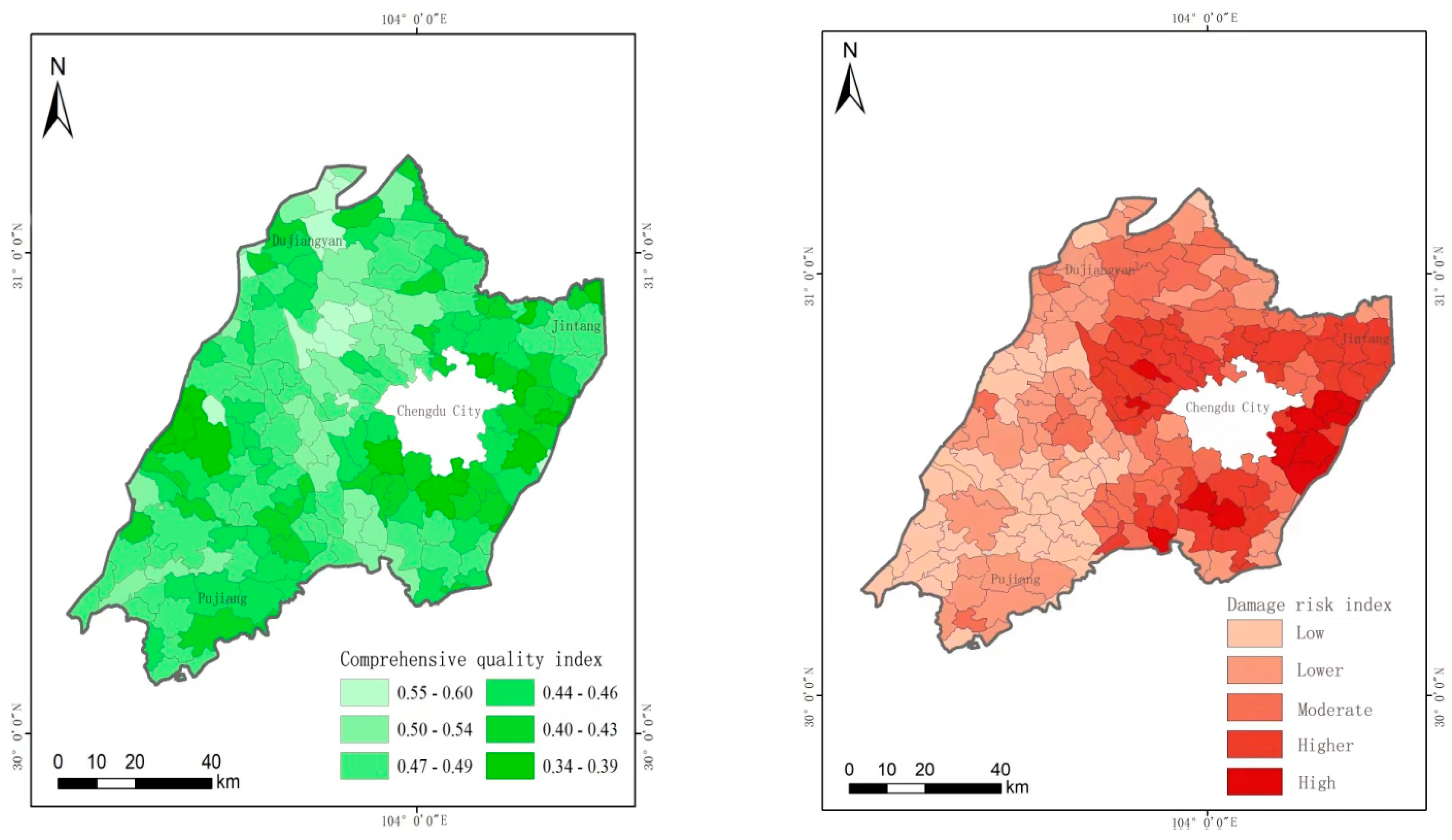
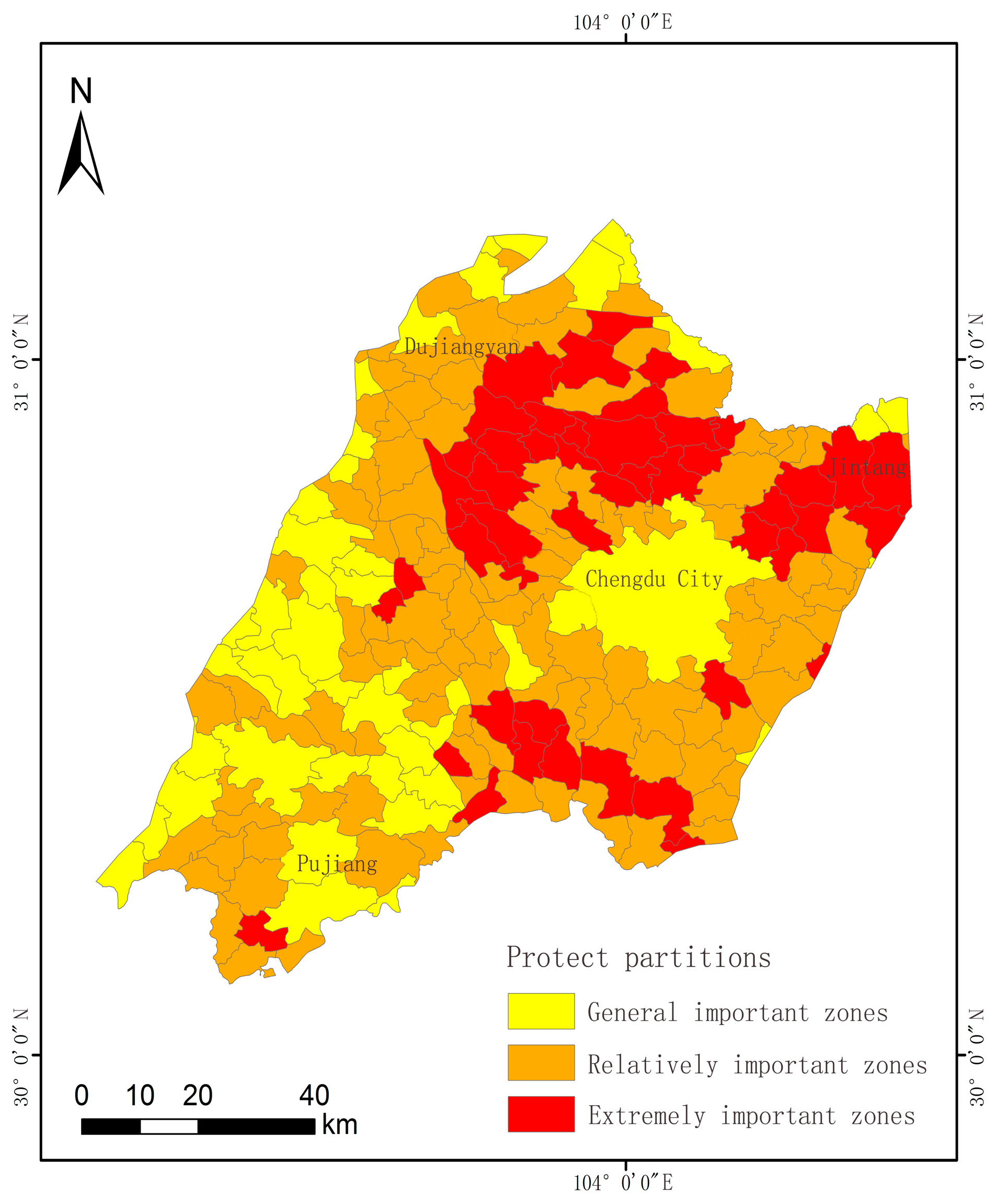
| Content | Evaluation Methods of Number of Substances (Number of Functions) | Value Evaluation Methods | Notes |
|---|---|---|---|
| Material products | Actual yield of material products | Market value method | Values of small-sized, middle-sized, and large-sized HG material product supplies are USD 2867, 6195, and 1350/year, respectively [37]; |
| Headwater conservation | Comprehensive water-holding capacity method | Cost substitution method | Headwater conservation refers to the average value of different types of forest lands in Chengdu Plain [38,39]; The calculation of the headwater conservation value refers to Technical Norms for Calculation of Ecological Product Values. |
| Soil conservation | Universal soil loss equation (USLE model) | Cost substitution method | Soil conservation refers to the average value (100 t/ka) of different types of HGs in Chengdu Plain [40]; The calculation of the soil conservation value refers to Technical Norms for Calculation of Ecological Product Values. |
| Carbon sequestration | Net primary productivity method | Market value method | Vegetation-based carbon sequestration volumes of small-sized, middle-sized, and large-sized HGs were 0.26, 0.81, and 1.56 t/a, respectively [41]; The carbon sequestration price per unit chooses the listing-agreed price of carbon emission amount (CEA) of China’s carbon market in Shanghai Environment and Energy Exchange. |
| Climate regulation | Vegetation-absorbed heats | Cost substitution method | The absorbed heats of evergreen broad-leaf forest in Chengdu Plain is 100 KJ/ha [42]; The calculation of the climate regulation value refers to Technical Norms for Calculation of Ecological Product Values. |
| Pollination | Effects of HG pollinator on typical crop yield | Market value method | Typical crops (rice, oilseed rape, corn and wheat) in Chengdu Plain are chosen for value evaluation, according to the pollination dependence degree of crops [43]; |
| Biodiversity maintenance | Shannon–Wiener Diversity Index of species | Equivalent factor method | The average Shannon–Wiener Diversity Index of HGs in Chengdu Plain is 2.51 [44]. According to Technical Norms of Forest Ecosystem Service Evaluation (2020), the biodiversity maintenance value per unit area is USD 1372/ha. |
| Cultural services | Tourism consumption per people | Travel cost method | A comprehensive statistical analysis on the agritainment ticket price of HGs and entertainment income is carried out [45]. |
| Criteria Layer | ||||||
| A-C | A | B | C | CI value | Relative weight | |
| A | 2 | 1/2 | 1 | 0.0056 | 0.2857 | |
| B | 4 | 1 | 2 | 0.5714 | ||
| C | 1 | 1/4 | 1/2 | 0.1429 | ||
| Index Layer | ||||||
| A-A3 | A1 | A2 | A3 | CI value | Relative weight | |
| A1 | 3 | 1/2 | 1 | 0.0092 | 0.3200 | |
| A2 | 4 | 1 | 2 | 0.5580 | ||
| A3 | 1 | 1/2 | 1/3 | 0.1220 | ||
| B-B4 | B1 | B2 | B3 | B4 | CI value | Relative weight |
| B1 | 1 | 3 | 2 | 2 | 0.0035 | 0.4232 |
| B2 | 1/3 | 1 | 1/2 | 1/2 | 0.1222 | |
| B3 | 1/2 | 2 | 1 | 1 | 0.2273 | |
| B4 | 1/2 | 2 | 1 | 1 | 0.2273 | |
| C-C3 | C1 | C2 | C3 | CI value | Relative weight | |
| C1 | 1 | 2 | 3 | 0.0046 | 0.4232 | |
| C2 | 1/2 | 1 | 2 | 0.1222 | ||
| C3 | 1/3 | 1/2 | 1 | 0.2273 |
| Objective Layer | Criteria Layer | Weights | Index Layer | Weights |
|---|---|---|---|---|
| HG comprehensive quality index | Landscape stability (A) | 0.2857 | Average patch density (A1) | 0.3200 |
| Average patcharea (A2) | 0.5580 | |||
| Evenness index (A3) | 0.1220 | |||
| Ecological functions (B) | 0.5714 | Headwater conservation value (B1) | 0.4232 | |
| Soil conservation value (B2) | 0.1222 | |||
| Carbon sequestration value (B3) | 0.2273 | |||
| Biodiversity maintenance value (B4) | 0.2273 | |||
| Social cultural functions (C) | 0.1429 | Number of residents per unit area (C1) | 0.5400 | |
| Cultural service value per unit area (C2) | 0.2970 | |||
| Material product supply value per unit area (C3) | 0.1630 |
| Experts | 1. Rural Population Density | 2. Land Development and Utilisation | 3. Per Capita Net Income of Farmers | 4. Distance to the Built-Up Area | 5. Regional Economic Level | |||||
|---|---|---|---|---|---|---|---|---|---|---|
| Survey 1 | Survey 2 | Survey 1 | Survey 2 | Survey 1 | Survey 2 | Survey 1 | Survey 2 | Survey 1 | Survey 2 | |
| Expert 1 | 3 | 3 | 9 | 9 | 5 | 5 | 7 | 7 | 1 | 1 |
| Expert 2 | 3 | 3 | 9 | 9 | 7 | 5 | 5 | 7 | 1 | 1 |
| Expert 3 | 1 | 3 | 7 | 7 | 3 | 5 | 9 | 9 | 5 | 1 |
| Expert 4 | 3 | 5 | 9 | 9 | 1 | 3 | 7 | 7 | 5 | 1 |
| Expert 5 | 5 | 1 | 9 | 9 | 3 | 5 | 7 | 7 | 1 | 3 |
| Expert 6 | 1 | 3 | 9 | 7 | 3 | 5 | 7 | 9 | 5 | 1 |
| Expert 7 | 1 | 1 | 7 | 9 | 3 | 5 | 9 | 7 | 5 | 3 |
| Expert 8 | 5 | 3 | 7 | 9 | 9 | 7 | 3 | 5 | 1 | 1 |
| Expert 9 | 7 | 5 | 5 | 9 | 1 | 3 | 9 | 7 | 3 | 1 |
| Expert 10 | 7 | 3 | 9 | 7 | 5 | 5 | 3 | 9 | 1 | 1 |
| Expert 11 | 1 | 3 | 9 | 9 | 5 | 5 | 7 | 7 | 3 | 1 |
| Expert 12 | 3 | 3 | 5 | 9 | 1 | 5 | 9 | 7 | 7 | 1 |
| Expert 13 | 5 | 1 | 3 | 7 | 9 | 5 | 7 | 9 | 1 | 3 |
| Expert 14 | 7 | 3 | 9 | 9 | 3 | 5 | 1 | 7 | 5 | 1 |
| Expert 15 | 7 | 3 | 3 | 9 | 9 | 7 | 5 | 5 | 1 | 1 |
| Factors | Average Importance | Standard Deviation of Importance | CV | Weight Coefficients | ||||
|---|---|---|---|---|---|---|---|---|
| Survey 1 | Survey 2 | Survey 1 | Survey 2 | Survey 1 | Survey 2 | Survey 1 | Survey 2 | |
| Rural population density | 3.93 | 2.87 | 2.29 | 1.15 | 0.58 | 0.40 | 0.16 | 0.11 |
| Land development and utilisation | 7.27 | 8.47 | 2.17 | 0.88 | 0.30 | 0.10 | 0.29 | 0.34 |
| Per capita net income of farmers | 4.47 | 5.00 | 2.78 | 1.03 | 0.62 | 0.21 | 0.18 | 0.20 |
| Distance to the built-up area | 6.33 | 7.27 | 2.39 | 1.24 | 0.38 | 0.17 | 0.25 | 0.29 |
| Regional economic level | 3.00 | 1.40 | 2.07 | 0.80 | 0.69 | 0.57 | 0.12 | 0.06 |
| No. | Contents | Value in 2018 /USD Million | Proportion /% | Value in 2008 /USD Million | Proportion /% |
|---|---|---|---|---|---|
| 1 | Material products | 4724.06 | 15.46 | 5448.69 | 16.59 |
| 2 | Headwater conservation | 1448.58 | 4.74 | 2197.13 | 6.69 |
| 3 | Soil conservation | 111.85 | 0.37 | 135.52 | 0.41 |
| 4 | Carbon sequestration | 35.38 | 0.12 | 41.19 | 0.13 |
| 5 | Climate regulation | 1103.75 | 3.61 | 1573.42 | 4.79 |
| 6 | Pollination | 8883.45 | 29.07 | 14,505.93 | 44.18 |
| 7 | Biodiversity maintenance | 4337.85 | 14.19 | 6183.68 | 18.83 |
| 8 | Cultural services | 9917.79 | 32.45 | 2750.72 | 8.38 |
| Total | 30,562.70 | 100.00 | 32,836.28 | 100.00 | |
Disclaimer/Publisher’s Note: The statements, opinions and data contained in all publications are solely those of the individual author(s) and contributor(s) and not of MDPI and/or the editor(s). MDPI and/or the editor(s) disclaim responsibility for any injury to people or property resulting from any ideas, methods, instructions or products referred to in the content. |
© 2023 by the authors. Licensee MDPI, Basel, Switzerland. This article is an open access article distributed under the terms and conditions of the Creative Commons Attribution (CC BY) license (https://creativecommons.org/licenses/by/4.0/).
Share and Cite
Liu, Q.; Yan, K.; Yan, Y. Evaluation of Ecosystem Service Value of Homegarden in Chengdu Plain and Relevant Protection Strategy. Forests 2023, 14, 1754. https://doi.org/10.3390/f14091754
Liu Q, Yan K, Yan Y. Evaluation of Ecosystem Service Value of Homegarden in Chengdu Plain and Relevant Protection Strategy. Forests. 2023; 14(9):1754. https://doi.org/10.3390/f14091754
Chicago/Turabian StyleLiu, Qin, Kun Yan, and Yangyang Yan. 2023. "Evaluation of Ecosystem Service Value of Homegarden in Chengdu Plain and Relevant Protection Strategy" Forests 14, no. 9: 1754. https://doi.org/10.3390/f14091754
APA StyleLiu, Q., Yan, K., & Yan, Y. (2023). Evaluation of Ecosystem Service Value of Homegarden in Chengdu Plain and Relevant Protection Strategy. Forests, 14(9), 1754. https://doi.org/10.3390/f14091754






